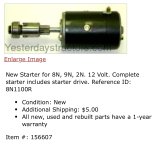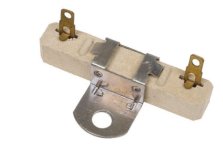In post 5 he said it is the resistor on the junction block at the dash.
Ditto !There is NO junction block on the front mount BUT guys use terms they don't know is correct. May be calling the 12250 Ballast Resistor a 'junction block'. He also says he is "burning up the ceramic resistor" but that could be the OEM 9N-12250 Ballast Resistor or the aftermarket 1.5 OHM External Resistor used with a 6V Coil. Again unclear. When I see/read "ceramic" I am thinking the aftermarket external part. When I see/read "junction block" I think p/n 8NNN-14448, used with all side mount units when the change was made in 1950, and when the 12250 Ballast Resistor was obsoleted. To clarify:
9N-12250 - OEM Ballast Resistor, used '39-'50 only with front mount distributor.
8NNN-14448 - Junction Block, used only with side mount distributor, when the 12250 Ballast Resistor was obsoleted.
8N-10306 - External Inline 1.6 OHM Resistor; used only with a 6V Coil in a 12V system.
Tim Daley (MI)
FWIW & FYI : The OEM 9N-12250 Ballast Resistor was originally ceramic and IT WILL GET HOT! It can be red glowing. When you install a new resistor, at first power-up it will get hot and smoke a bit. Don't panic and think you've freid something -this is normal. Burning up a Coil, 6V or 12V, is NOT normal so suspect your wiring is incorrect somewhere in the system. How did you verify the coil was "'burning up"? How do yiou plan to 'test'
Tim Daley (MI)
I have a 49 8n that has recently developed an issue of burning up the ceramic ignition resistor. The tractor has been converted to 12v and new wiring harness installed earlier this year. After running for a short time the resistor starts glowing red and catches fire. It’s happened twice so far and usually also ends of burning up the 12v ignition coil as well. I haven’t had time yet to try and test for a short circuit, but also I’m limited to how long the resistor lasts to check voltages. Anyone have something similar happen?
Thanks
Rob
FWIW & FYI : The OEM 9N-12250 Ballast Resistor was originally ceramic and IT WILL GET HOT! It can be red glowing. When you install a new resistor, at first power-up it will get hot and smoke a bit. Don't panic and think you've fried something -this is normal. Burning up a Coil, 6V or 12V, is NOT normal, and 'catching fire' is certainly not normal which indicates a bad wiring issue. I suspect your wiring is incorrect somewhere in the system. How did you verify the coil was "'burning up"? How did you plan to "test the circuit for shorts" and where & how to look at voltages? Many just start probing their VOM without knowing exactly where to test and what to look for.
You need to:
1. Disconnect Battery and Lights. Lights were never a factory feature and many are wired incorrectly, often root cause for shorts.
2. Go thru entire wiring system with a VOM set to Continuity, and do not use an idiot test light. Use the correct wiring PICTOGRAM by JMOR.
3. Verify all the wiring is correct for the Front Mount 8N; do you have the correct GENERATOR and belt tensioner, VOLTAGE REGULATOR, and START MOTOR? All wiring harness must be right.
4. Lastly, the front mount distributor is often the root cause for non-starting. If not tune-up, timed, and tested correctly then mounted correctly, it will be a problem.
Your local ALT/GEN shop can bench test Battery, GEN, VR, and Starter Motor, usually at no charge (pun intended)
Tim Daley (MI)














